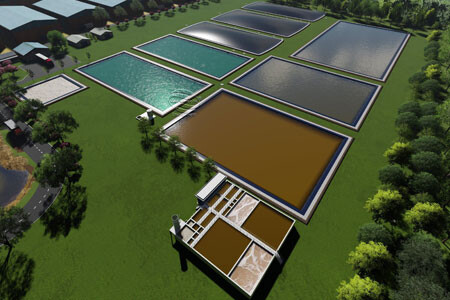Discover the wastewater treatment system (150 m³/day) designed and constructed by VIET WATER JSC for...
Vietnam: Government towards renewable energy sources
The Government of Vietnam since the end of 2015 has issued Decision No. 2068/QD-TTg with the goal: "Mitigating greenhouse gas emissions in energy activities compared to the normal development plan".

Image of icons of renewable energy. Photo from www.renewableenergy.org.vn
Since then, the government has approved Vietnam's Renewable Energy Development Strategy (RE) to 2030, with a vision to 2030. Specifically, the contribution rate of renewable energy sources is as follows: “About 5% in in 2020; about 25% by 2030 and about 45% by 2050”.
According to many experts, if Vietnam is determined to act, it can completely achieve the above-mentioned goals, first of all because our country converges with favorable natural conditions for the development of various forms of wildlife. Clean electricity is the most important.
Natural conditions: Great potential
Compared with many countries, Vietnam has many advantages to strongly develop the renewable energy power industry. Because, we have a great natural potential of different renewable energy sources distributed throughout the country.
Indeed, solar energy in Vietnam is distributed throughout the country and is abundant with an average solar radiation of 5kWh/m2/day. According to data from the Ministry of Industry and Trade, each year Vietnam has about 2,000-2,500 hours of sunshine with an average sun exposure of about 150kCal/cm2, equivalent to a potential of about 43.9 million tons of oil equivalent/year.
Besides, wind energy is also quite abundant with about 3,400 km of coastline. According to calculations, the potential for electricity generation from wind energy can reach 24GW. In detail, on land, the total wind power capacity can reach about 800-1,400 kwh/m2/year. Capacity in coastal areas; The Central Highlands and the South can reach about 500-1,000 kWh/m2/year, while in other areas it can reach less than 500 kWh/m2/year.
Lower than the above types of energy, but equivalent biomass energy is equivalent to about 43-46 million tons of oil, of which 60% comes from wood waste and 4% comes from agricultural waste. In addition, biomass from agricultural products or wastes is equivalent to 10 million tons of oil per year. Biogas potential of approximately 10 billion m3 per year can be obtained from garbage, animal manure and agricultural waste.
Geothermal energy also deserves attention. Particularly in the Red River Delta, where wind and solar energy resources are limited due to climate factors, studies show that geothermal energy is quite positive with many geothermal basins in the Southeast region. -Northwest, geothermal fault zone of Lo River-Vinh Ninh...
In addition, there are biomass sources from agricultural products or wastes with an output equivalent to 10 million tons of oil per year. Biogas potential of approximately 10 billion m3 per year can be obtained from garbage, animal manure and agricultural waste.
And finally, it should not be forgotten that the role of small hydroelectricity (with capacity less than 30MW) should not be ignored with a total potential capacity of more than 4000MW…
Government policies
Since 2011, a national electricity development master plan for the period 2011-2020 with a vision to 2030; called Power Plan VII, has been issued. After 5 years of operation, that Master Plan has proved to be no longer relevant to the developments of the actual situation of the country and the world. On the other hand, the trend against greenhouse gas emissions that warm the Earth's atmosphere is not taken into account.
Therefore, at the end of 2015 the government issued a new project to adjust the national electricity development plan for the period 2011-2020 with a vision to 2030; called Power Planning VII Adjustment.
According to the Power Plan VII, the target by 2020 is that the electricity output from renewable energy (renewable energy) accounts for 38% of the total national electricity output, including both large and medium hydropower (101/265 TWh); by 2030 account for 32% (186/572 TWh).
The reserve of renewable energy (RE) power sources has not caught up, affecting the safety of electricity supply, the revised Power Master Plan VII has proposed the target of RE power output in 2020 to account for a lower proportion, only about 32% (ie absolute value is only 84.1 TWh, of which small hydroelectricity, wind power, solar power, biomass power ... is 17.3 TWh) and renewable energy output in 2030 is only 23.1 % (ie absolute value is only 131 TWh, of which small hydroelectricity, wind power, solar power, biomass power... about 60.9 TWh).
The master plan also predicts that the capacity of all types of electricity will be developed by 2020 and 2030 as follows:
Small hydropower 3500 MW/6000 MW
Biomass, biochemical, geothermal power… 940 MW/3400 MW
Wind power 710 MW/6000 MW
Solar power 850 MW/11800MW
Total RE sources 6004 MW(2020)/27200 MW(2030)
Obviously, according to the revised Power Plan VII above, the total capacity of renewable power sources by 2030 will increase more than four times compared to the previous 10 years (2020). As a result, the exploitation of renewable energy will help Vietnam reduce its dependence on imported energy sources, ensure energy security for the country and at the same time reduce emissions of a part of harmful greenhouse gases. his compatriots.
Accompanying the set planning targets, the Government of Vietnam has issued many policies to encourage the development of renewable energy, set targets for using renewable energy and aim for a competitive electricity market with renewable energy sources. diversified investment and business models. In addition, the government has supplemented Vietnam's National Renewable Energy Development Strategy not only to 2020, 2030 but also with a vision to 2050.
Realizing the above Strategies, the Government has also been encouraging the development and use of new and renewable energy; provide financial support for research and pilot production and development of pilot models; exempt from import tax, production and circulation tax.
However, according to experts, the peculiarity of renewable energy is that it depends a lot on natural conditions (water, sun, wind, geographical location...), technology and production costs. Therefore, to promote the development of renewable energy, the government should have supportive policies such as quota mechanism, fixed price mechanism, bidding mechanism and certification mechanism.
There is another important point that cannot be overlooked, that is, despite investing in the development of such renewable energy sources, after 15 years (in 2020), thermal power sources that are harmful to the environment still account for a large proportion. over the 50%.
Distribution of electricity sources in our country 2020. Image from wordpress.com.
This means that to get fresh air for our country and for the Earth in general, investment in clean electricity sources is a big and long-term requirement. Of course, renewable energy sources alone cannot be replaced immediately, the replacement process must take many more decades. Not to mention the issue of cost.
Meanwhile, nuclear power plants; Similar to renewable power plants, there are no greenhouse gas emissions and nuclear power is also considered a clean source of electricity. Therefore, the government has included the plan to build the first nuclear power plants in the Power Plan VII and also in the Adjusted Power Plan VII.
Obviously, the national policies to develop our country's electricity industry have been formed. The problem is implementation responsibility. That is the responsibility of the relevant ministries, branches, localities and, above all, the Government.
By: VietNamNet


